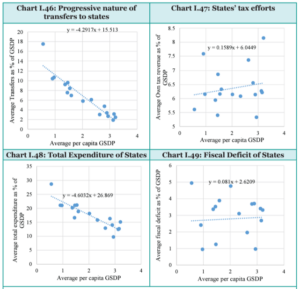
State-led growth: As one of the fastest-growing large economies globally, India has much to be proud of, including its macroeconomic stability, a young and vibrant population, and a globally successful diaspora. However, alongside these achievements, Indian economy faces profound challenges that threaten to derail its growth trajectory. These challenges are particularly evident in the delivery of essential services such as education, health, public safety, and justice, where significant gaps remain despite substantial public spending.
India’s economic model has been successful in some respects, particularly in fostering a globally competitive IT sector, a robust pharmaceutical industry, and high-skill-intensive manufacturing. Yet, this model has also resulted in a significant segment of the population—nearly 50%—being left out of the growth process. This segment, primarily residing in rural areas, remains heavily dependent on welfare programmes for survival.
The exclusion of a large part of the population not only hampers social equity but also limits India’s overall economic potential. The challenge is not merely one of income distribution but of ensuring that the bottom half of the population has access to quality education, health services, and other basic needs. Without this, India cannot hope to achieve its full economic potential.
READ I Greenwashing: How corporates play the system to avoid accountability
Ineffective delivery of essential services
The central problem lies not in a lack of awareness or policy intent but in the effectiveness of the Indian state in delivering these essential services. Despite numerous policy documents and broad consensus on the need for better human development, the translation of policy goals into reality has been weak. This weakness stems from significant governance deficits that pervade all areas connected with the delivery of public goods and services.
As highlighted in a 2018 paper by Rakesh Mohan, the way forward for accelerated growth in India is being held back by major governance deficits in all areas related to public service delivery. This sentiment is echoed by Professor Lant Pritchett, who dramatically argues that the weak performance of the Indian state is one of the ten greatest challenges facing humanity, considering the size of the problem and the number of people affected.

These governance challenges manifest in several ways. For instance, in education, despite spending over Rs 7.5 lakh crore annually, a significant portion of rural children complete primary school without basic literacy skills. In health, 35% of children are stunted, impairing their long-term economic potential. The justice system is plagued by a backlog of over 30 million cases, many of which are related to land, capital, or credit, thereby stalling economic activity.
Public safety remains a substantial challenge, particularly in its impact on female labour force participation, which is deterred by safety concerns. These problems reflect a broader issue within the Indian economy, where a top 10% drives growth while the remaining population, especially the bottom 50%, is left behind, primarily supported by welfare programmes.
Needed: A state-led growth strategy
Given these challenges, a state-led economic growth strategy, where individual states take charge of their development trajectories, emerges as a promising solution. India’s diversity—economic, cultural, and social—means that a one-size-fits-all approach is unlikely to work. Instead, states should be empowered to tailor their economic strategies to their unique circumstances, leveraging local strengths and addressing specific weaknesses. The effectiveness of governance begins with localised service delivery.
States should focus on improving the efficiency of their public spending by investing in governance reforms that prioritise accountability, transparency, and efficiency. This includes adopting technology-driven solutions to reduce leakages in welfare programs and improving data quality for better decision-making. Furthermore, better governance is not just about spending more money but about spending it effectively. The idea that simply increasing budgets for sectors like education or health will lead to better outcomes is misguided. What is needed is a fundamental rethinking of how public sector funds are allocated and used, with a focus on performance-linked pay, better supervision, and innovative approaches to human capital development.
Human development must be prioritised as a means to sustain economic growth. Investing in education, health, and nutrition is critical to building a skilled and healthy workforce that can drive future growth. States should experiment with innovative solutions, such as performance-linked pay for public sector employees, which has been shown to significantly improve outcomes in sectors like education. In Andhra Pradesh, for example, a large-scale randomised evaluation showed that introducing biometric smart cards to reduce leakage in welfare programs yielded a return on investment ten times greater than the cost of the intervention. Similar approaches could be applied across various public services to improve outcomes without necessarily increasing overall spending.
Need better management of public finances
Public finance management is another critical area for reform. The effectiveness of public spending is as important as the amount spent. States should focus on improving the efficiency of their expenditures, particularly in areas that offer high social returns on investment, such as early childhood education and public health. This requires a shift away from “government as usual” approaches, where spending decisions are driven more by political expediency than by evidence of what works. For instance, hiring additional Anganwadi workers has been shown to significantly improve learning outcomes and reduce child malnutrition, with returns on investment estimated to be 12 to 20 times the cost.
Revenue mobilisation and fiscal decentralisation are also essential for empowering states to align their fiscal policies with their development priorities. Fiscal decentralisation would allow states to raise and allocate resources more effectively, enabling them to invest in areas that drive long-term growth. However, India remains one of the most over-centralised countries in the world in terms of public expenditure, with only 3% of government spending occurring at the local level. By comparison, nearly 50% of public expenditure in China happens at the local level, highlighting the need for a more decentralised approach in India.
States should also play a more active role in integrating markets and leveraging the private sector to complement public services. This can be particularly effective in sectors like education and healthcare, where private providers can help fill gaps left by public services. However, this requires robust regulatory frameworks to ensure that the private sector operates in a manner that serves the public interest.
Given the current weaknesses in public service delivery, there has been a large-scale exit to the private sector, with 50% of urban school enrolment in private schools and 70% of primary care provided by private providers. While this reflects a rational response to state underperformance, it underscores the need for stronger state capacity to regulate and leverage the private sector effectively.
India’s future economic success hinges on empowering its states to take the lead. By focusing on improving governance, prioritising human development, enhancing public finance efficiency, and embracing fiscal decentralisation, states can drive a more inclusive and sustainable growth model. This decentralised approach not only recognises India’s diversity but also harnesses it as a strength, allowing each state to contribute to the nation’s overall progress. However, to truly accelerate development, India must shift the focus of its economic discourse from the traditional growth versus development debate to a more nuanced understanding of the quality of expenditure.
Simply put, it is not just about how much we spend but how effectively we spend it. By prioritising governance reforms that enhance state capacity, India can unlock the full potential of its public spending, enabling the country to achieve both higher growth and better development outcomes.
India’s economic growth strategy must be led by its states, each of which is uniquely positioned to address its specific challenges and opportunities. This state-led growth approach, grounded in better governance and more effective public spending, offers a path forward that can ensure that the benefits of growth are shared by all citizens, not just a privileged few. By focusing on the fundamentals of state capacity and governance, India can chart a course toward sustained and inclusive economic development that truly meets the aspirations of its people.
(This article is based on a presentation made by Prof Karthik Muralidharan, Tata Chancellor’s Professor of economics at the University of California, San Diego, at an online discussion organised by EGROW Foundation.)
